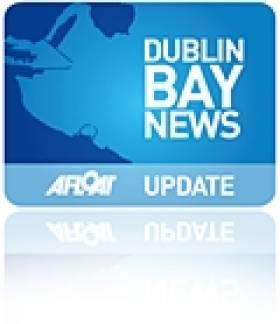Displaying items by tag: Maritime Instiute of Ireland
#Lectures- A lecture: The History of Asgard, from Launch to Gun Running to Conservation by Pat Murphy as previously reported on Afloat.ie is to take place tonight (8pm) in the National Maritime Museum of Ireland (NMMI), Dun Laoghaire.
This lecture is a ticketed event –admission is €10.00 (payable at door from 7.30pm) for further details, click HERE.
In addition to this lecture, the NMMI are holding another lecture tonight (in the Stella Maris Seafarers Club, Beresford Place, close to Busaras Bus Station). The lecture (starting at 8pm) titled: History of the Irish Naval Service is to be presented by Terry Cummins of the Irish Naval Association.
As usual these monthly held lectures are organised by the Maritime Institute of Ireland and held in the city-centre venue of the Stella Maris Seafarers Club. Entry is by voluntary donation to help meet overheads of the M.I.I. which runs the National Maritime Museum in Dun Laoghaire.
For further information contact Barney Yourell, Lectures Officer of the Institute on 087 900 7466 or (01) 847 6118
Public transport: The nearest DART stations are Connolly Station and at Tara Street in addition to the LUAS (Red) line stop at Busáras. Car parking is located in the Irish Life Mall (ILAC) on Lower Abbey Street.
For further information in general about the National Maritime Museum, Dun Laoghaire which has a gift shop and café: visit www.mariner.ie
#PRESIDENT REOPENS MARITIME MUSEUM- President Michael D. Higgins officially performed the reopening ceremony of the €4m restored National Maritime Museum of Ireland in Dun Laoghaire today, reports Jehan Ashmore.
An ecumenical service was held by Canon Victor Stacey, Dean of St. Patrick's Cathedral Dublin, who up until recently was Minister at Christ Church & Mariners in Dun Laoghaire. The Dean was also joined by the town's Rev. Christopher Kennedy from the York Road Presbyterian Church and Mons. Dan O'Connor, Parish Priest of St. Michaels Church.
Follwing the blessing, the President spoke of his admiration for the beautiful building and of those many people over the years that helped to establish the Maritime Institute of Ireland (M.I.I.) and its museum through it many functions and role in the coastal town.
In particular the President paid tribute to the late Dr. John de Courcy Ireland, who was a prominent member of the M.I.I. and was made honorary research officer of the institute which was formed in 1941. It was in that same year that the President remarked was the year of his birth.
Following his speech a plaque to mark the occasion was unveiled by the President on the steps leading up to the altar of the apt venue of the former Old Mariners Church where more than 200 people witnessed the historic occasion. Those in attendance from the diplomatic corps included ambassadors from Argentina, Britain and France.
Among the other dignitaries where the Lord Mayor of Holyhead, local T.D's including Brian Hayes, Minister of State at the OPW which was ultimately responsible in the museum's renovation project. Funding came mostly from the Government, nationwide donations and volunteer-led collections.
The building project included major electrical and fire safety improvements, repairing stain-glass windows, and re-roofing. In addition repointing of the granite-cut building hewn from Dalkey granite which was built in 1836 for the Church of Ireland for mariners. The building is one of the last such structures still intact in the world.
Several years after the church closed in the early 1970' the Maritime Institute of Ireland moved into the building where the museum remained open until 2004.
Since then the building had undergone extensive renovation and modernisation. The museum which has been open to the public since April has exhibits from throughout Ireland and more will be added too in the future according to Peadar Ward, president of the M.I.I.. He added that they look forward to also displaying marine paintings and to hosting lecture programmes in the premises.
Also in attendance where crew members of the Naval Service L.E. Roisin (P51) which made a special port of call to Dun Laoghaire Harbour, berthing along the East Pier.
In addition members of the Irish Naval Association, the local RNLI lifeboat and sea scouts welcomed the President, where the day's events included a planting of an oak tree in the grounds of the building located close to the towns harbour waterfront.
#CHOIRAL CONCERT - The Luther College Nordic Choir from Iowa in the US is to perform a concert in aid of the Maritime Institute of Ireland's National Maritime Museum.
The choir conducted by Dr Allen Hightower, will be held in Monkstown Church of Ireland at 8pm next Wednesday 23 May. Tickets cost €10.
In early June the refurbished National Maritime Museum of Ireland in Dun Laoghaire is to be officially re-opened by President Michael D. Higgins. For information about the institute and museum which has been open to visitors since Easter visit www.mariner.ie
Christmas Concert for Maritime Museum
#EVENTS-A light-hearted performance of Christmas Music for the Festive Season is to be held at Christ Church Park Road, Dún Laoghaire in aid of the Maritime Institute of Ireland's museum restoration fund.
All are welcome to the evening's performance by the 'Firhouse Singers' which starts at 7.30 pm on Friday 16th December. Refreshments will be available and an admission of €10.00 at the door.
For additional information about the museum visit www.mariner.ie
National Commemoration Services for Irish Seafarers
#EVENTS-The annual Seafarers Commemoration in Cork will be held at 12 noon, on 28th November in the Port of Cork Offices, Custom House Quay.
The event is organised by the Cork branch of the Maritime Institute of Ireland which also hosted the Seafarers Commemoration in Dublin last Sunday where a mass was held at City Quay Church. Wreaths were laid afterwards at the nearby Irish Seaman's National Memorial, for the men of the Irish mercantile marine who lost their lives at sea during the Second World War.
In the afternoon, a commemoration service of those who lost their lives on Irish ships also took place at Evensong in St. Patricks Cathedral.
As the 'family of the sea' gathered at the City Quay memorial, this provided an opportunity to reflect memories of former seafarers. In recent years, the memorial service has been extended to honour all Irish seafarers who have died at sea.
For further information detailing lists of Irish merchant ships lost during WW2 and the names of those seamen lost, click HERE in addition a short video clip depicting war footage and paintings of Irish vessels lost.
Yesterday marked the 20th anniversary of the sinking of the B&I Line containership Kilkenny in Dublin Bay in which three crew lost their lives in a collision with the German owned Lo/Lo Hasselwerder.
A memorial to the incident in 1991 is located at Irish Continental Group's (ICG) headquarters in Dublin Port, where the former state-run B&I Line was based before privatisation and sold to ICG's ferry subsidiary Irish Ferries.
































































